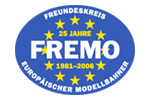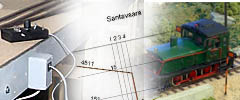


Welcome to FREMO-FIN

FREMO is not totally new in Finland, The first Finnish FREMO modules (although using German prototype) were constructied in 1988, but the time was not ready yet for modular concepts like FREMO. The second wave started in 2001 when Johannis Likos showed his greek FREMO modules at Lahti exhibition. Later in 2004 Martin Janda from Zababov club studied at Helsinki University of Technology and introduced the FREMO concept to Tapiola club members. The most significant start took place under the leadership of Kari Hovinmaa, Johannis Likos and Kari Saalasti, a small group of individual enthusiast from Tapiola club, got together and started the FREMO module construction. Today (2025) we have 90+ FREMO modules, including five stations and two fiddle yards, and more are under construction ranging geographically from Helsinki on southern coast to Oulu in the northern part of Finland.
We would like to point out that FREMO-FIN — as we call ourselves — is in no way connected to Tapiola club, it just happened that the first FREMO modules of this wave were constructed by Tapiola club members, and that the Tapiola club also built a few FREMO modules.
To guarantee interchangeability of the few modules we have at hand the informal FREMO-FIN group has intentionally tried to limit the number of variations to a minimum. We are only suggesting the use of F96 interface and H0 gauge, and no catenary.
Regarding wheels, we have a somewhat controversial situation in Finland. Most Finnish modellers are running commercial ready-to-run equipment of foreign prototype, because practically nothing is available ready-to-run in the Finnish outline. Almost all of the Finnish outline rolling stock is actually scratch or kit built. The problem is having nothing between ready-to-run foreign outline and self built finnish outline rolling stock. This leads to a problematic situation and strikes an elitic or finescale impression over all Finnish outline modellers, and hence of course to FREMO-FIN. This is not what we want. We need more enthusiasts, but we do not wish to scare the would-be FREMO enthusiasts by insisiting on using finescale wheels, three-point suspension etc. All kit built Finnish outline rolling stock already has RP25/110 wheels, as those are easily avaliable in almost any size, yet we wish to have the possibility of using commercial underframes of wagons or locos. Thus we are closer to FREMO H0-Europa NEM than any of the fine scale versions of FREMO — yet we run with brass locos — see the problem?
This also leads to problems with couplers. Rolling stock with commercial underframes have NEM couplers or at least NEM coupler pockets. The brass modellers have the screw link imitations or Kadee couplers and are not so willing to put the doghouse sized NEM socket under the buffer beam. Although our standard insists on NEM couplers we have to give lattitude here and wait what the defacto coupler will turn out to be.
Our localised standards are based on the Norwegian standard but the track & wheel standards are closer to H0-Europa-NEM (min. 14.3 mm back-to-back, min. 2.4 mm tyre width, max. 1.1 mm flange depth, RP25/110 recommended).
FREMO meetings are not intended for the public. So far we have only being running at model exhibitions. The slow phased action on a FREMO layout gives nice contrast to other, mostly merry-go-around layouts, usually on show at Finnish exhibitions. Unfortunately the nature of a public shows is considered by some of us to force us also having something moving all the time. The slow phased switching on a lonely branch line using wagon cards is not close to every finnish FREMO enthusiast's heart — yet.
The Finnish FREMO-FIN has just started, we are now running using timetables and fast-time clocks, things that actually make FREMO layout a FREMO layout. Waybills and wagon cards we don't have yet, but perhaps one day...
The virtual "Stammtisch" (in Finnish) is on first Tuesday of every month at about 18 o'clock.
Please contact in advance if you would like to join (contact information below).
Further information
- Antti Rahko
- e-mail: antti [cattail] fremo [dot] fi
- Petri Koskela
- e-mail: petri [cattail] fremo [dot] fi
9240 kävijää/visitors
© 2008-2023 FREMO-FIN Viimeksi päivitetty / last modified (none). Created with Notepad.
Pages tested with W3C validator -- didn't look good ;)
Tekstit, kuvat ja piirokset ovat tekijänoikeuslain suojaamia. Tekniset ratkaisut, menetelmät ja lähdekoodit ovat vapaasti kopioitavissa ja hyödynnettävissä ei-kaupallisissa tarkoituksissa. Kaikki kehitystyö on tehty vapaa-aikana ja pääosin henkilökohtaisilla varoilla eikä hyötymistarkoituksessa, siksi materiaalin käyttö hyötymistarkoituksiin (sisältäen kaverille rahasta rakentamisen!) on kielletty ilman kirjallista lupaa! Sivuilla esiintyy virheitä. Jos käytät sivujen tietoja hyväksesi, teet sen täysin omalla vastuullasi. Mikäli kehität sivuilla esiettyjä ajatuksia kytkentäkaavioita tai koodia edelleen, on sinun asetettava se maksutta kaikkien saataville esimerkiksi Internetiin. Odotamme vastavuoroisesti tietoa suoritetusta edelleenkehitystyöstä.
Sivut testattu W3C validatorilla -- ei hyvältä näytä :)